Posted by: Ken @ 10:12 pm
Too often, a photo fails to match one’s perception of a scene. How many times have I said, “If only I had a camera,” to capture an inspiring event. Conversely, how many times does the photograph fall so short of expectations? The simple explanation is that photos can record only two dimensional visual images. The experience itself involves so much more than a collection of shapes and colors.
Mary Lou and I set out before sunrise this morning to walk our little patch of recovering Everglades. Earlier this week I found fresh Bobcat scat (click on photo for more information, with apologies to the queasy):
We have had more luck seeing Bobcats early in the morning, and this morning we were not disappointed. We cautiously approached the secluded entry point of the trail that runs on top of the levee. As is our habit, we quickly looked both ways before coming out into the open.
To our right, about 20 feet away, a Bobcat saw us, and before I could aim my camera it began trotting away down the trail: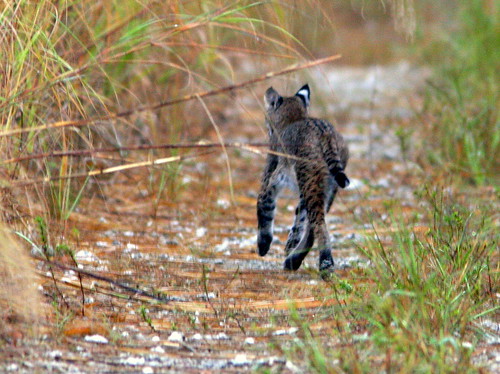
The Bobcat then ducked into the cover of high grass:
My special “sitting spot” near an extinct alligator hole usually yielded Swamp Sparrows and Prairie Warblers at this time of year. Today they did not appear, but an unusually beautiful female Northern Cardinal posed on some vegetation that had been burnt back by the recent hard frost:
Her colorful mate was nearby:
We then “power walked” another half mile north on the unpaved section of Miramar Parkway that will one day soon become a busy link between I-75 and US-27, stopping to view a Snowy Egret perched in a small tree on the banks of the Harbour Lakes impoundment:
Wood Storks have been less common lately, hopefully because conditions in their secluded rookeries have just the right amount of underlying water to keep the raccoons out, yet not so much as to let the alligators in. This younger Wood Stork (having not yet acquired the white neck and fully bald head of an adult) has probably bypassed this breeding season:
We might have easily overlooked this immature Little Blue Heron and called it an “egret,” but we noticed its white is ever so slightly suffused by a bluish tint, and its gray bill is tipped with black: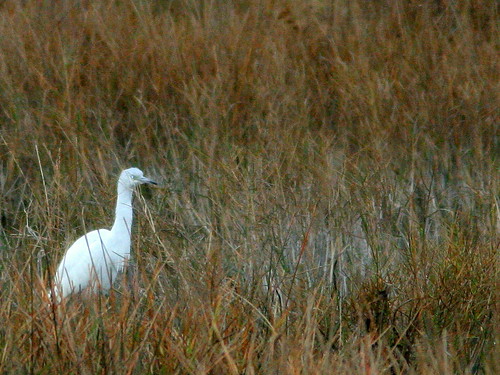
While returning from our walk, Mary Lou and I saw a flock of Tree Swallows about 1/4 of a mile ahead. They looked like a huge smoke plume. We were standing near the center of the graded and unpaved westernmost section of Miramar Parkway/SW 196th Avenue. The flock spread across about 90 degrees of the eastern horizon (from about 11 o’clock to 2 o’clock, above high grass on 4 foot levees and some distant small trees) in front and to our right. The flock actually faded into the horizon to our right front quarter and also into the distance directly in front of us.
Is it possible to estimate the number of birds in this flock? (click on the photo to see all five original photos):
My camera has a 420 mm telephoto system (300mm f/4 with a 1.4x extender). I did not have a wide angle lens. I estimate that my camera’s field of view included about 10 degrees of horizon and captured about half of the height of the column of birds. My photos included the lowest portion of the flock, where the birds were more densely aggregated.
I took five non-overlapping photos from nearly adjacent sections of the flock, mostly in front of me, during a 9 second interval (08:33:10 to 08:33:19). My long lens so limited the field that my 5 photos could not have covered more than 10% of the entire flock– possibly as little as 5%.
I selected one photo that was fairly representative of the five shots, taken in about the center point of the flock. This photo was cropped lightly down to screen size (88.9% of original size) and sharpened in Picasa. Using Paint.net, I re-sized my photo to 110 x 87 cm, or 9570 sq cm. I then outlined four 20 x 20 cm squares (400 sq cm each, for a total area of 1600 sq cm) diagonally across a representative sample of the photo, lightly colored each square, then greatly enlarged the image on the computer screen, and counted the number of birds (mostly specks) within each square.
I counted the birds in each of the four colored squares:
From the upper left, the 4 squares respectively contained 126, 206, 320 and 260 birds, for a total of 912 birds. This works out to 912 birds per 1600 sq cm, or 0.57 birds per square centimeter. Thus, the entire image contained approximately 5,455 birds (9570 sq cm x 0.57 birds/sq cm). If, in fact, my entire sample of 5 similar photos (27,275 birds) included only 50% of the flock, there were over 54,000 Tree Swallows in that single flight. If a quarter of the flock, it numbered 108,000 birds. I believe even this may be too conservative an estimate. If my impression is accurate, that the 5 photos only represented about 10% of the flock, there were a staggering 300,000 Tree Swallows in that seething cloud! At 21 grams apiece, the flock may have had a biomass of over 57 tons! This number, plus all those who were hidden under the high horizon to my right, as well as those that disappeared into the lower horizon (distant tall palm trees) in front.
As is usually the case, I wanted to hang around and take more photos, and Mary Lou decided to walk back home. A little ways ahead, as she rounded a bend in the gravel road, she froze to watch a small doe that had emerged from the high grass. This was about where the Bobcat had disappeared, so we wondered whether the cat had chased it out into the open:
Florida White-tails seem scrawny in comparison to those near our Illinois home:
As it turned out, I was not finished with the swallows, or maybe they were not finished with me. I had taken a shortcut to the levee trail, in hopes of intercepting the doe as she returned to the wetlands. Sure enough, the deer crossed right in front of me, but did not give me time for another photo.
As I stood in a clear area on the levee, the huge flock of Tree Swallows reappeared, heading in from the Everglades, low and fast, straight towards my position:
As they flew over I could hear a chorus of soft chirps and the rush of wind in their wings. Almost on cue, the entire flock changed direction at once with a loud “woosh.” Perhaps unwisely, I remembered the David Sibley eGuide to the Birds of North America app in my iPod and played the Tree Swallow calls. Almost immediately, the swallows began to circle my position. The entire flock of thousands seemed to be suddenly headed my way! I kept repeating the calls of the species, and the density of swallows surrounding me steadily increased. They flew within a few feet of my head in a counter-clockwise pattern (do Southern Hemisphere swallows circle in the opposite direction?). Some were nearly at ground level.
Their cries now emerged from a surreal dizzying vortex with me at the center, nothing like anything I have ever before experienced (click on photo for more views):
For a long vertiginous moment, it seemed that the birds were suddenly frozen in place, so still in the sky, and it was I and the trail and the trees who were spinning, now clockwise. I did not want the swallows to stop, but I felt a bit guilty for having excited them so. For minutes after I turned off the recorded calls, they continued to wheel around me. Even after I walked down off the levee toward home, I looked back to see the swallows, still circling my former position.
Oh, how I regretted that I did not have my point-and-shoot camera to capture the depth, the expanse, the dynamics of this flock of swallows. But it was an experience more spiritual than visual, to be felt, not seen. A photo is not enough.













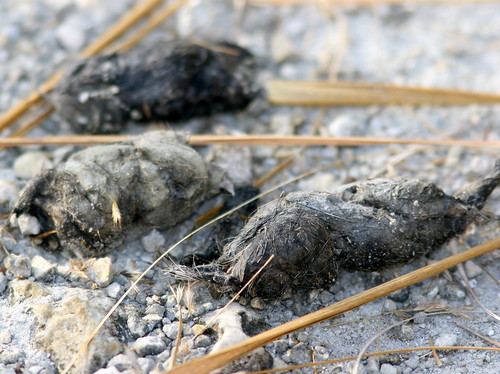
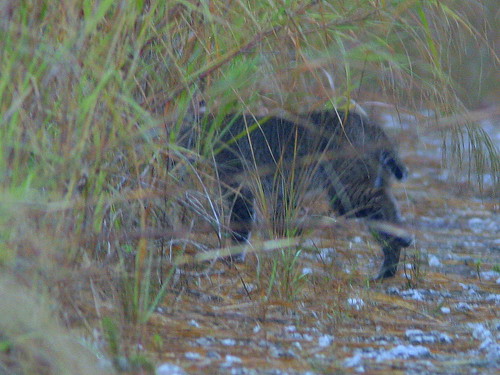
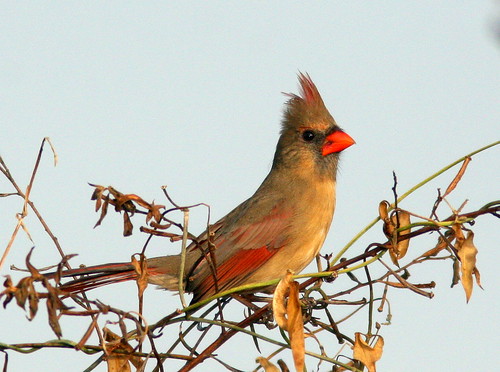
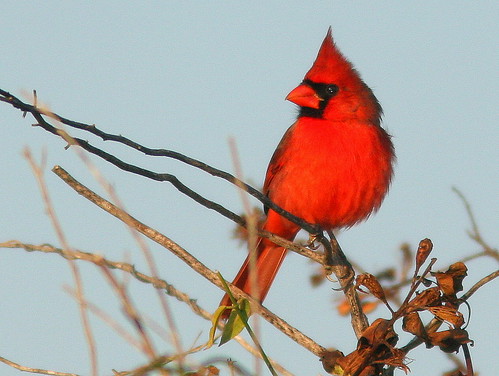

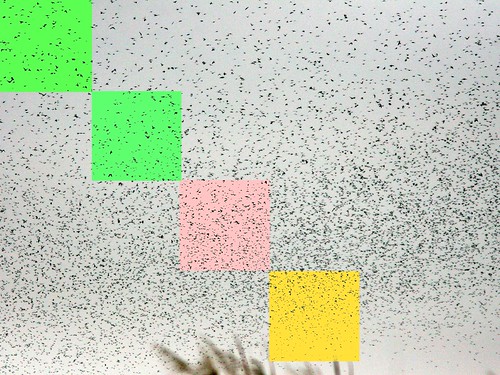


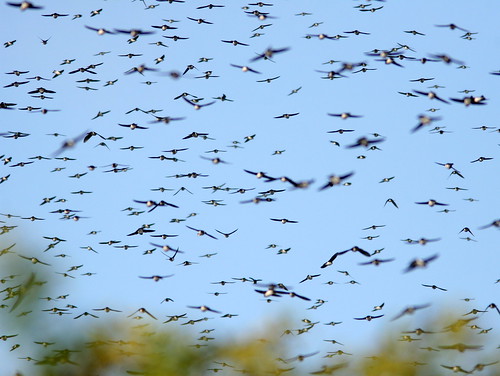
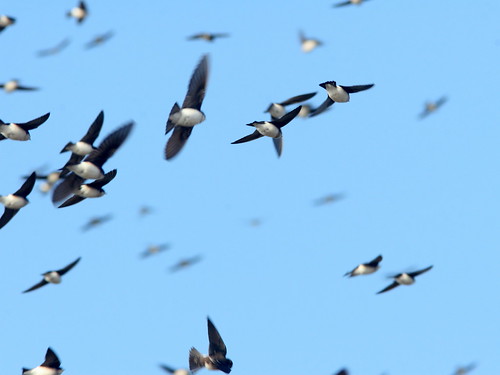
December 30th, 2010 at 10:45 am Oh, wow, that is just amazing. The entire walk was memorable, but the tree swallow experience is one in a million. One of those ‘time stood still’ moments. ~karen
December 30th, 2010 at 11:26 am All great shots, but the bobcat even though he is retreating is impressive. Boom & Gary of The Vermilon River, Canada.